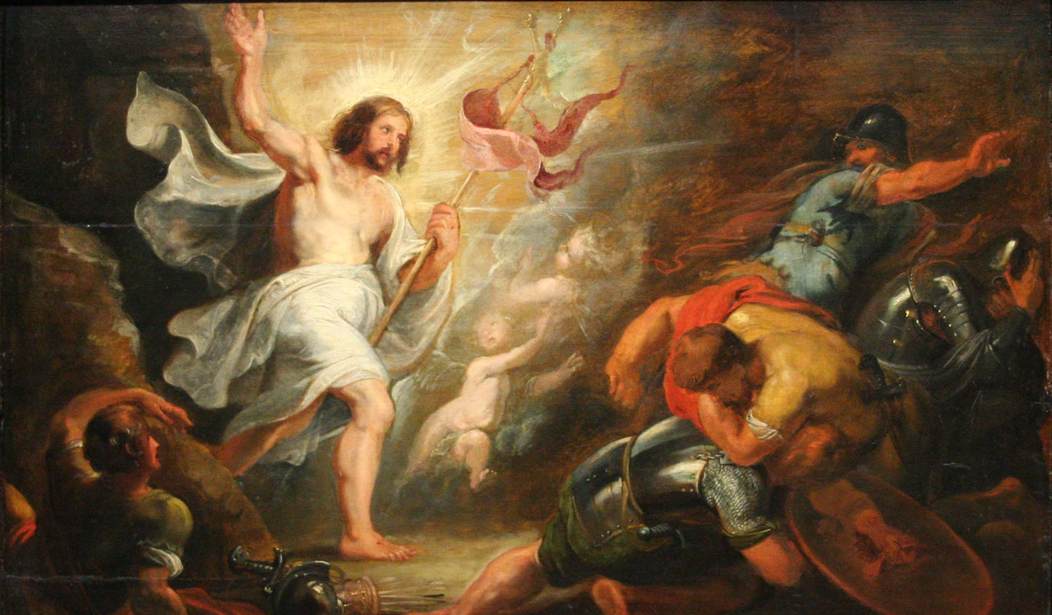“And the angel answering, said to the women: Fear not you; for I know that you seek Jesus who was crucified. He is not here, for he is risen, as he said. Come, and see the place where the Lord was laid. And going quickly, tell ye his disciples that he is risen: and behold he will go before you into Galilee; there you shall see him.” —Matthew 28:5-7
Happy Easter, a blessed Pascha to you all! Today we Christians celebrate the Resurrection of Jesus Christ, His triumph over sin, death, and the devil, a triumph in which we share. In the pagan myths, gods take on the forms of men to exploit or domineer over mortals. In the true story of Christ, however, God became man that He might redeem us and give us a share in His divine life, both on earth and most especially in Heaven.
On this greatest of Christian holy days, I would like to share a Gospel reflection inspired by the commentary of St. Jerome, the great Biblical scholar of the Church’s early ages who dedicated his life to studying God’s word. How better to understand the Resurrection than to read accounts of it in the Gospels themselves, with the aid of a wise theologian (for, as 2 Peter 1:20 says, “no prophecy of Scripture is made by private interpretation”).
St. Jerome, arguably the greatest Biblical scholar in history, translated the Bible from its original Greek, Hebrew, and Aramaic into Latin (which at that time was the common or “vulgar” language, hence the name “Vulgate”). He spent many years on this labor of love, consulting other experts, studying the intricacies of each language, and as exactly as possible translating each verse into the common tongue of Latin. His translation, indeed, is so superb that it was the standard among Catholics for over a thousand years. “Ignorance of the Scriptures,” said St. Jerome, “is ignorance of Christ.”
By translating the Bible into Latin, he hoped to bring others to read and love the Word of God. In his commentary on the Resurrection as related in Matthew’s Gospel, we see Jerome’s multi-faceted exegesis, explaining both the material and spiritual significance of the event, noting how Christ is fully human and yet also God, ruling nature and renewing it through His Death and Resurrection:
Our Lord is one and the same Son of God and Son of man. According to both natures, divinity and flesh, he shows signs, now of his greatness, now of his humility. This is why in the present passage [Matthew 28:2-3], though it is a man who was crucified, buried, and shut in the tomb, whom a stone holds back in opposition, nevertheless the things that are done outside show him to be the Son of God: the sun takes flight, darkness falls, the earth quakes, the curtain [of the Temple] is torn, the rocks split, the dead are raised, there are services of angels, which even from the beginning of his birth proved that he was God… Now, too, an angel comes as a guard of the Lord’s tomb. By his bright clothing he expresses the glory of the triumphant one…
The guards are completely terrified with fear… yet the angel consoles not them but the women: ‘Do not be afraid.’ Let them be afraid, he says. Panic persists in those in whom abides unbelief. But as for you, since you are seeking the crucified Jesus, hear this: he has been resurrected and has fulfilled his promises.
At Christ’s death, the Gospels tell us that the sky grew dark (Mark 15:33, Luke 23:44), there were earthquakes (Matthew 27:51), and dead people walking abroad (Matthew 27:53). Nature was at war with itself and mankind, as sin for a moment seemed to triumph.
Recommended: Israel’s Passover Message: Hamas Will Lose, Hostages Will Return
But on Easter morning, the sun blazed forth, angels spoke to men, and Christ walked abroad—not an animated dead body, but fully alive and never to die again. Sin was conquered, death vanquished, and both the natural and supernatural were in harmony. That does not mean that there were no longer sinners, of course. Just after the Resurrection, the Roman guards lied about what they saw at the tomb and the Jewish officials bribed the guards to lie. But no longer could such evil men have the final say. Salvation is now possible for all, Jew and Greek, male and female, slave and free (Galatians 3:28). If we stay true to Christ, we too will one day rise again with glorified bodies to enjoy everlasting bliss. And so we affirm, as the old Latin and Byzantine response goes, that Christ is risen—indeed He is risen!










Join the conversation as a VIP Member